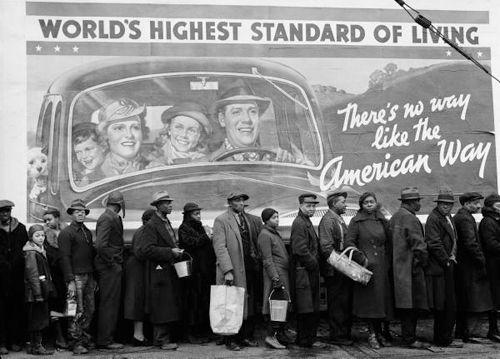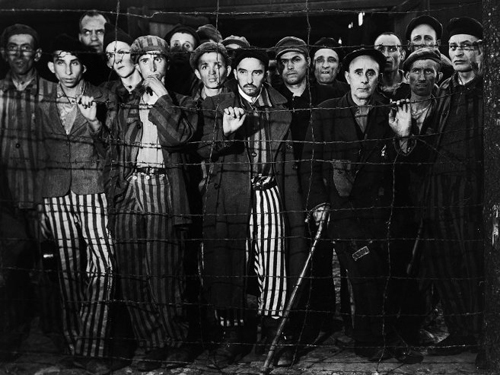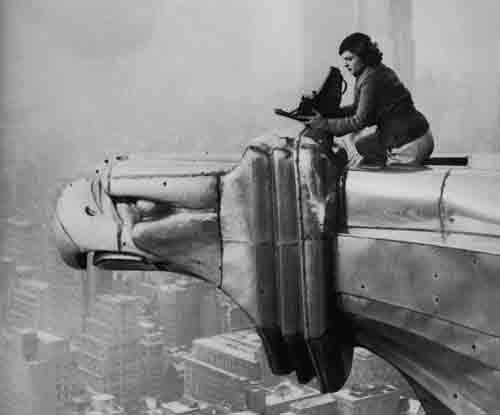 At the Time of the Louisville Flood (1937)
At the Time of the Louisville Flood (1937)
“If you want to photograph a man spinning, give some thought to why he spins. Understanding for a photographer is as important as the equipment he uses.” –Margaret Bourke-White
“Utter truth is essential and that is what stirs me when I look through the camera” –Margaret Bourke-White.
Margaret Bourke-White (1904-1971) died from the effects of Parkinson’s disease the year I was born. In her 67 years she accomplished an astonishing amount for one lifetime, for anyone, let alone for a woman of her generation. She is worth studying not only for her work but an intentional life well, and intrepidly, lived.
 The Liberation of Buchenwald, April 1945 (1945)
The Liberation of Buchenwald, April 1945 (1945)
Bourke-White was an American documentary photographer, known for several things, all connected to her photography: she was the first foreign photographer allowed to photograph within the Soviet Union, was the first female war correspondent, and the first female photographer working for LIFE magazine. What began as a career in in commercial photography was still one marked by a willingness to work – and thrive – in places into which women were traditionally denied access. One of her first clients was Otis Steel, and despite a battle to get onto the factory floors, she created some of the best steel factory photographs of that era, before moving on to work with LIFE, documenting the unfolding human drama of her day in the Soviet Union (1930) and the American south, before World War 2 began, when she became the first female war correspondent accredited by the US Army, and the first woman allowed to work in combat zones during the war, returning to the Soviet Union to document life there, giving the West it’s first real look at life behind the iron curtain. She was in Moscow when Germany broke the pact of non-aggression and invaded, and was the only foreign correspondent there at the time. Eventually she was one of the first photographers in to, and to document, the Nazi death camps, about which she said, “Using a camera was almost a relief. It interposed a slight barrier between myself and the horror in front of me.”
“The very secret of life for me…was to maintain in the midst of rushing events an inner tranquillity. I had picked a life that dealt with excitement, tragedy, mass calamities, human triumphs and suffering. To throw my whole self into recording and attempting to understand these things, I needed an inner serenity as a kind of balance.” ~ Margaret Bourke-White
 Margaret Bourke-White, working atop the Chrysler Building, by Oscar
Margaret Bourke-White, working atop the Chrysler Building, by Oscar
Graubner (1934)
She seemed to have a knack for being in the right place at the right time, but I have a feeling it had more to do with dogged determination than luck. To wit: one of her most iconic photographs was one of Gandhi sitting at his spinning wheel, two years before his assassination in 1948. Before she could make the photograph, Gandhi insisted she learn to use the spinning wheel, which she did. She became one of the most effective chroniclers of the violence that erupted at the independence and partition of India and Pakistan (1947).
“The camera is a remarkable instrument. Saturate yourself with your subject and the camera will all but take you by the hand.” ~ Margaret Bourke-White
“Any photographer who tries to portray human beings in a penetrating way must put more heart and mind into his preparation than will ever show in any photograph.” ~ Margaret Bourke-White
In 1949 to 1953 she photographed South African apartheid and the Korean War, eventually retiring from LIFE in 1969, well into her struggle with Parkinson’s.
Over her life she published 12 photography books, and an autobiography, Portrait of Myself, in 1963.
You can find her amazing work still in print in Margaret Bourke-White: Moments in History and read more about her life in Portrait of Myself (autobiography by Margaret Bourke-White)


Comments
Thank you for this article! I cannot believe that I never heard of this courageous and interesting women before… I will definitely read more about her….
Hey David,
Great post! Remarkable career… Anyone who can perch on the roof of the Chrysler building holding a Graflex RB Super D has got some serious moxie!!
Best,
Craig
This has been the most satisfying read in your Study the Masters series. Thanks for the post. I can only add, having visited Auschwitz/Birkenwald, where it felt almost sacrilegious to take photographs, I can appreciate the heart it takes to be a war correspondent or a photographer of the misfortunes of others.